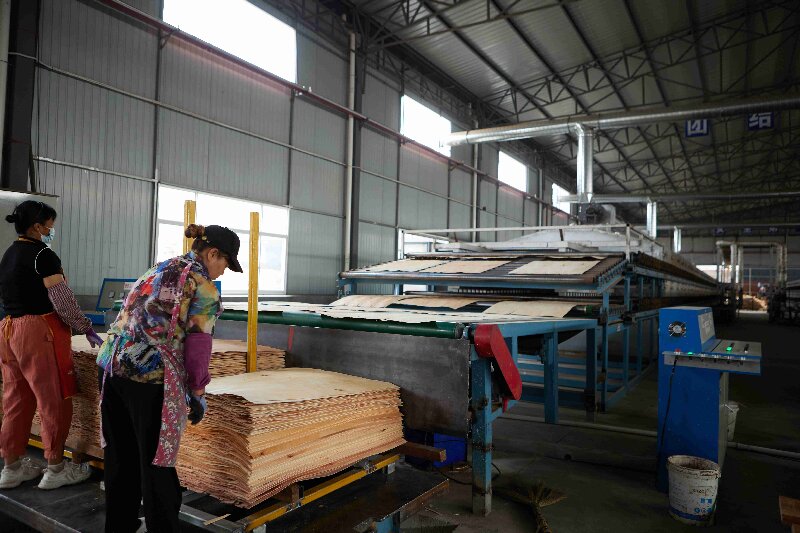Choosing environmentally friendly boards is a crucial step in the decoration process. The quality of the board directly determines the durability, safety, and aesthetic appeal of home interiors. With growing environmental awareness, more consumers are opting for sustainable wood-based panels that combine performance with eco-friendliness.
But what exactly are wood-based panels, and how can you ensure you're selecting the best quality? This guide will walk you through the key factors in evaluating wood-based panels, including moisture content, bonding strength, and environmental standards. Additionally, we’ll explore how advanced wood veneer drying technology enhances panel quality and durability.
Wood-based panels are engineered products made from wood or other plant fibers that undergo mechanical processing, adhesive bonding, and pressing. These panels are widely used in furniture, flooring, and interior decoration due to their stability, strength, and cost-effectiveness.
Blockboard – A core of solid wood strips sandwiched between veneers, offering good stability.
Plywood – Multiple thin wood layers (veneers) glued together in alternating grain directions for strength.
Particleboard (Chipboard) – Made from wood chips bonded with resin, often used in budget furniture.
Medium-Density Fiberboard (MDF) – Fine wood fibers compressed with adhesive, ideal for smooth finishes.
OSB (Oriented Strand Board) – Engineered with aligned wood strands for high load-bearing capacity.
Eco-Friendly Boards (Low-Formaldehyde Options) – Such as CARB P2-compliant or F4-star rated panels.
The quality of these panels largely depends on the veneer drying process, adhesive quality, and manufacturing precision.
To ensure you're selecting high-performance panels, consider these five critical quality indicators:
Definition: The percentage of water weight relative to dry wood weight.
Ideal Range: 8–12% for most applications.
Why It Matters:
If moisture content exceeds 16%, panels may warp, crack, or develop mold.
Proper veneer drying in manufacturing ensures uniform moisture distribution.
Wood veneer dryers with steam heating or biomass burners help achieve optimal moisture levels.
Definition: Measures a panel’s ability to withstand bending forces.
Why It Matters:
Higher values mean greater durability (important for shelves, tabletops, and flooring).
Poorly dried veneer can weaken the core structure, reducing bending strength.
Modern wood veneer dryers ensure even heat distribution, enhancing panel rigidity.
Definition: The adhesive’s ability to hold veneer layers together.
Why It Matters:
Weak bonding leads to glue separation (common in low-cost plywood).
High-quality veneer drying ensures proper resin curing for maximum adhesion.
Definition: Evaluates how well the panel resists water-induced peeling.
Why It Matters:
Panels with poor immersion stripping fail in humid environments (e.g., kitchens, bathrooms).
Thermally modified veneers (via advanced veneer drying) exhibit better water resistance.
Emission Standards:
E0 (Super Low Formaldehyde): <0.5mg/L (Safest for homes)
E1 (Low Emission): <1.5mg/L (Meets EU standards)
E2 (Higher Emission): Avoid in enclosed spaces
Why It Matters:
Low-formaldehyde boards improve indoor air quality.
Eco-friendly wood veneer dryers (e.g., biomass-powered) reduce the carbon footprint in production.
The veneer drying process is crucial in manufacturing high-performance wood panels. Traditional sun-drying is unreliable, while modern wood veneer dryers offer precision control.
Steam-Heated Roller Veneer Dryers
Use steam for uniform heat distribution.
Ideal for large-scale production.
Biomass-Powered Veneer Dryers
Burn wood waste (bark, sawdust) for cost-efficient drying.
Reduces reliance on fossil fuels.
Hot Air Circulation Dryers
Suitable for small workshops.
Less energy-efficient than steam or biomass systems.
✔ Faster Drying Times → Higher production efficiency
✔ Lower Energy Costs → Biomass burners cut fuel expenses
✔ Consistent Quality → Prevents warping & cracking
✔ Eco-Friendly → Reduces formaldehyde emissions
Check Core Materials – Solid wood cores (e.g., poplar, pine) offer better stability than low-density fillers.
Inspect Surface Veneer – Look for smooth, defect-free finishes (avoid peeling or uneven textures).
Verify Supplier Certifications – Choose manufacturers with FSC, CARB, or ISO 9001 compliance.
Prioritize Low-Formaldehyde Options – E0 or E1 grades for healthier indoor air.
Ask About Drying Methods – Panels dried in advanced wood veneer dryers last longer.
Selecting the right wood-based panels requires attention to moisture control, bonding strength, and eco-friendliness. Advanced veneer drying technology plays a vital role in ensuring panel durability and performance.
For manufacturers, investing in high-efficiency wood veneer dryers (like steam-heated or biomass-powered systems) can cut costs, improve quality, and support green production.
For consumers, choosing E0/E1-certified panels ensures safer, longer-lasting furniture and interiors.
Need expert advice on wood-based panels or veneer drying solutions? Contact us today!

Copyright By © Shandong Shine Machinery Co.,Ltd